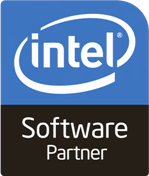Information Technologies in Innovation System of Russia |
Igor Agamirzian |
| Abstract
The list of Critical Technologies approved by the Russian President includes a large number of areas that make part of the IT sector. These explicitly include at least the following:
Additionally, the list of Critical Technologies includes a number of areas that are largely integrated into or dependent on the traditional-sense IT, for instance:
It is to be noted that no headway in any other areas can be made without IT as a platform for R&D. The IT sector has become an infrastructure element of vital importance to the innovation-oriented development. In other words, IT has turned out to be an industry that has not less — or, frequently, even more — bearing on economics and social life than power engineering, engineering and car or aviation industry. Since the industrial revolution any new industry follows a number of visible stages. Stage One can be called “garage stage”: having constructed in a garage (or a barn) the first car, glider or PC, one could — with a certain probability — set up a leading company that will take up a significant market share. Stage Two involves competition for a market share between these companies that ends up in a consolidation towards a limited number of major domestic and global players, who then gradually absorb virtually all market participants. This was the way followed by the car industry, the aircraft industry (major producers such as General Motors or Boeing have consolidated dozens of less fortunate companies that used to be eminent brands) — and this is what we see today in the IT industry. Market leaders nurture their development largely on acquisition of smaller companies and featuring their technologies and products into their own product lines, etc. Apparently, at this stage, it turns out to be impossible to make a “garage” company into a market leader. There are, though, few examples of global leaders that have grown out of purely administrative measures — e.g. Airbus in Europe — but at this stage creation of a global player requires government or even inter-government scale of investment. Unfortunately, this “garage leader” stage in the IT industry was hopelessly missed in Russia. As a matter of fact, this period ended in other countries about the same time as the Soviet Union collapsed, and the newborn innovation companies — this time in Russia in 1990s — found themselves in a cut-throat technology and market competition with global leaders which has only spared, and catalyzed, a limited number of niche producers, such as, for instance, ABBYY, 1C or Kaspersky Lab. The next innovation wave that surged up due to the development and mass penetration of Internet opened a window of opportunity for “garage companies” in the second half of 1990s, and Russian innovators made an appropriate use of it. This period witnessed the rise of national innovation leaders such as Yandex, Mail.ru etc. Unfortunately, none of them rose to the global leaders’ level, and as of today consolidation in this industry segment is controlled by different players. This failure to enter the top division, however, does not mean that innovations in the industry are facing lower demand. What is changing drastically is the exit strategy of innovation companies. “Exit” here, as the traditions of venture capital have it, means capitalization of investments — i.e., getting profit on a successful project. Whereas “garage”-stage leaders can make headway on self-financing and organic growth (“bootstrap”) — and that was the way with most global IT leaders such as Microsoft and Intel, for example — advanced-stage, consolidation-and-takeover-stage innovation companies are in bad need for external investments. Additionally, whereas a “garage” leader can see its exit in setting up a global corporation, with petty investments with handsome return paid off by capitalization when the corporation goes public, innovation start-ups of the consolidation stage in most cases will exit through the sale of their intellectual property or — even more often — the entire business to existing major players. Thus, today’s IT market being where it is, the main — and apparent — strategy for Russian innovation companies will be to develop their products and technologies up to a level of market presence which is attractive to large players. А problem, however, characteristic to the catch-up countries is the absence of truly large innovation businesses of national level. And traditional businesses, especially with the competition being so weak and the monopolization so strong, have no real motivation to purchase even products of innovation companies — not to mention the companies themselves or their intellectual property. That is why the consolidation of domestic players is rather slow and promises no efficient exit strategy for innovation start-ups. A potentially feasible strategy of purchasing technologies at a certain level of maturity from global brands and going global through the brands (the most typical example is Lenovo from China) is, unfortunately, not too probable for Russian companies — such a strategy requires a large horizontal market to make enough money for such purchase (or to present a level of maturity that can attract enough borrowings). That is why the most apparent, and potentially the most efficient exit strategy for Russian innovation IT companies is the sale of the company and/or its technology to one of the global leaders. Successful exits through this strategy are well known in the Russian IT industry, and one can expect a certain number of new success stories to come in the near future. The fact is that, unfortunately, this strategy is unscalable — i.e., it limits capital inflow to fixed amounts — and rather petty ones, as compared to income from the export of natural resources. Thus, successful development of Russian innovation IT companies requires incentives to the domestic demand for innovation products. Unfortunately, administrative-style incentives will, most probably, end up in nothing more than higher transaction costs, while institutional approaches require protracted and painstaking efforts on incubating institutes — something that should have been started much earlier. Notwithstanding the afore-said, the IT sector is destined to play a crucial role in innovating Russian economy, and those development institutions set up by Russian Government — first and foremost Russian Venture Company — must do their utmost to enable a faster development of innovation business in the IT sector. |
 Igor Agamirzian Bio Igor Agamirzian, Ph.D., was recently appointed as the Director General for Russian Venture Company. Before that from 2007 to 2009 he served as a General Manger of the Software Development Center of EMC Corporation in St. Petersburg, Russia. In his previous position he was a National Technology Officer and a member of the Cabinet of the Chairman of Microsoft in Russia and CIS countries. He was running Government Relations and Education programs for Microsoft in 2002-2004, prior to that he was responsible for managing relations for Microsoft Research with Computer Science research institutions in the Eastern Europe, including Russia and other CIS countries during 1999-2002. Before joining European Microsoft Research Lab in Cambridge, UK, Igor Agamirzian was running enterprise sales of the Microsoft Moscow subsidiary. He joined Microsoft in 1995 as a consultant of the Microsoft Consulting Services, and in 1996 started MCS practice in Moscow, Russia. Before joining business in 1991 as a co-founder and Technical Director of Astro Soft Ltd., a St. Petersburg based software development and system integration company, Igor Agamirzian had a 12-year background as a senior research fellow in the field of programming languages and computer architecture with the leading institutes of the Academy of Science of the USSR. Igor Agamirzian is an active Russian IT promoter within the international research and business community. In 1991 he published a first overview of the history and current state of the Soviet Computer Science in the widely known computer magazine “Computing in the U.S.S.R.” (Byte, April 1991). He is strongly involved in the international activities around Information and Communication Technologies, representing Russian private sector in the G8 DOT Force, an international taskforce on the Digital Divide and Information Society, and is often speaking on the business and research conferences. In year 2002 Igor Agamirzian was appointed as a Member of Advisory Board of the United Nations ICT Task Force.
|
| « Previous Keynote | All Keynotes | Next Keynote» |
| Invited Talks | Regular talks | Workshops | Types of presentations |
| All talks sorted by author name | All talks sorted by company name |




















